| کد مقاله | کد نشریه | سال انتشار | مقاله انگلیسی | نسخه تمام متن |
|---|---|---|---|---|
| 4510380 | 1624724 | 2012 | 11 صفحه PDF | دانلود رایگان |

Field experiments were conducted over two years to quantify the yield response to fungicide of spring barley (Hordeum vulgare L.) genotypes differing in disease severity and canopy structure. Fourteen genotypes were selected from a doubled-haploid mapping population to represent three distinct canopy phenotypes; tall with prostrate leaves, medium height with prostrate leaves and medium height with erect leaves. The fungicide treatments were based on a triazole plus strobilurin and chlorothalonil programme applied at the start of stem extension and during booting. Untreated plots served as controls. The major foliar diseases and disorders were powdery mildew and brown spotting in 2006 and powdery mildew, rhynchosporium barley leaf blotch and brown spotting in 2007, and genotypes differed significantly in the severity of each. Fungicide reduced powdery mildew and rhynchosporium symptoms in susceptible genotypes, but had little effect on spotting. The yield response to fungicide averaged across genotypes was approximately 1 t ha−1 and there was no significant difference in response between canopy types or genotype. The increase in yield was mostly via an increase in grain numbers m−2 with smaller or non-significant effects of fungicide on mean grain weight. When effects of fungicide on radiation interception were plotted against those on yield, a yield response of 0.8–1.4 t ha−1 was indicated in the absence of visible disease. The results show that the effects of fungicide treatment on grain numbers cannot be explained just in terms of protection of green area and increase in radiation interception. Nor were they the result of a delay in leaf senescence. Other possible explanations include control of symptomless infection at critical developmental stages, or direct effects of fungicides on plant metabolism. These findings have important implications for fungicide stewardship and disease management in barley, because the requirement for fungicide, as defined in terms of the likely yield response of the crop, cannot be predicted just from an assessment of the amount visible disease present or the risk of a disease epidemic developing.
► Yield response to fungicide of contrasting spring barley genotypes was investigated.
► Fungicide increased yield by increasing grain numbers to a similar extent in all genotypes.
► The increase was not related to control of visible disease and greater green area light interception.
► Fungicide requirement cannot be predicted just from assessments of visible disease.
Journal: Field Crops Research - Volume 139, November–December 2012, Pages 9–19